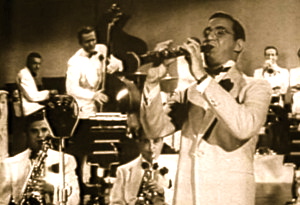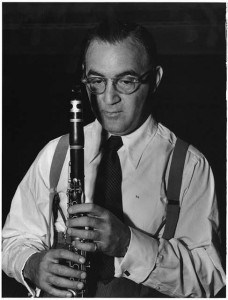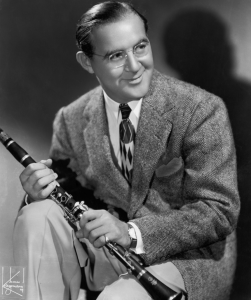Benny Goodman

Benny “King of Swing” Goodman
Benny Goodman, Gene Krupa, Harry James, Lionel Hampton
Benjamin David “Benny” Goodman (May 30, 1909 – June 13, 1986) was an American jazz and swing musician, clarinetist and bandleader; widely known as the “King of Swing.” In the mid-1930’s, Benny Goodman led one of the most popular musical groups in America. His January 16, 1938 concert at Carnegie Hall in New York City is described by critic Bruce Eder as “the single most important jazz or popular music concert in history: jazz’s ‘coming out’ party to the world of ‘respectable’ music.”
Goodman’s bands launched the careers of many major names in jazz, and during an era of segregation, he also led one of the first now well known racially-integrated jazz groups. Goodman continued to perform to nearly the end of his life, including exploring his interest in classical music.
Career
 Goodman left for New York City and became a successful session musician during the late 1920s and early 1930s (mostly with Ben Pollack‘s band between 1926 and 1929). A notable March 21, 1928 Victor session found Goodman alongside Glenn Miller, Tommy Dorsey, and Joe Venuti in the All-Star Orchestra, directed by Nat Shilkret. He played with the nationally known bands of Ben Selvin,Red Nichols, Isham Jones (although he is not on any of Jones’s records), and Ted Lewis. He recorded sides for Brunswick under the name Bennie Goodman’s Boys, a band that featured Glenn Miller. In 1928, Benny Goodman and Glenn Miller wrote the instrumental “Room 1411,” which was released as a Brunswick 78. He also recorded musical soundtracks for movie shorts; fans believe that Benny Goodman’s clarinet can be heard on the soundtrack of One A. M., a Charlie Chaplin comedy re-released to theaters in 1934.
Goodman left for New York City and became a successful session musician during the late 1920s and early 1930s (mostly with Ben Pollack‘s band between 1926 and 1929). A notable March 21, 1928 Victor session found Goodman alongside Glenn Miller, Tommy Dorsey, and Joe Venuti in the All-Star Orchestra, directed by Nat Shilkret. He played with the nationally known bands of Ben Selvin,Red Nichols, Isham Jones (although he is not on any of Jones’s records), and Ted Lewis. He recorded sides for Brunswick under the name Bennie Goodman’s Boys, a band that featured Glenn Miller. In 1928, Benny Goodman and Glenn Miller wrote the instrumental “Room 1411,” which was released as a Brunswick 78. He also recorded musical soundtracks for movie shorts; fans believe that Benny Goodman’s clarinet can be heard on the soundtrack of One A. M., a Charlie Chaplin comedy re-released to theaters in 1934.
During this period as a successful session musician, John Hammond arranged for a series of jazz sides recorded for and issued on Columbia starting in 1933 and continuing until his signing with Victor in 1935, during his success on radio. There were also a number of commercial studio sides recorded for Melotone Records between late 1930 and mid-1931 under Goodman’s name. The all-star Columbia sides featured Jack Teagarden, Joe Sullivan, Dick McDonough, Arthur Schutt, Gene Krupa, Teddy Wilson, Coleman Hawkins (for 1 session), and vocalists Jack Teagarden and Mildred Bailey, and the first two recorded vocals by a young Billie Holiday.
 In 1934 Goodman auditioned for NBC‘s Let’s Dance, a well-regarded three-hour weekly radio program that featured various styles of dance music. His familiar theme song by that title was based on Invitation to the Dance by Carl Maria von Weber. Since he needed new arrangements every week for the show, his agent, John Hammond, suggested that he purchase “hot” (swing) arrangements from Fletcher Henderson, an African-American musician from Atlanta who had New York’s most popular African-American band in the 1920’s and early 1930’s.
In 1934 Goodman auditioned for NBC‘s Let’s Dance, a well-regarded three-hour weekly radio program that featured various styles of dance music. His familiar theme song by that title was based on Invitation to the Dance by Carl Maria von Weber. Since he needed new arrangements every week for the show, his agent, John Hammond, suggested that he purchase “hot” (swing) arrangements from Fletcher Henderson, an African-American musician from Atlanta who had New York’s most popular African-American band in the 1920’s and early 1930’s.
Goodman, a wise businessman, helped Henderson in 1929 when the stock market crashed. He purchased all of Henderson’s song books, and hired Henderson’s band members to teach his musicians how to play the music.
 In early 1935, Goodman and his band were one of three bands (the others were Xavier Cugat and “Kel Murray” [r.n. Murray Kellner]) featured on Let’s Dance where they played arrangements by Henderson along with hits such as “Get Happy” and “Jingle Bells” from composer and arranger Spud Murphy. Goodman’s portion of the program from New York, at 12:30 a.m. Eastern Time, aired too late to attract a large East Coast audience. However, unknown to him, the time slot gave him an avid following on the West Coast (they heard him at 9:30 p.m. Pacific Time). He and his band remained on Let’s Dance until May of that year when a strike by employees of the series’ sponsor, Nabisco, forced the cancellation of the radio show. An engagement was booked at Manhattan’s Roosevelt Grill (filling in for Guy Lombardo), but the crowd there expected ‘sweet’ music and Goodman’s band was unsuccessful. The band set out on a tour of America in May 1935, but was still poorly received. By August 1935, Goodman found himself with a band that was nearly broke, disillusioned and ready to quit.
In early 1935, Goodman and his band were one of three bands (the others were Xavier Cugat and “Kel Murray” [r.n. Murray Kellner]) featured on Let’s Dance where they played arrangements by Henderson along with hits such as “Get Happy” and “Jingle Bells” from composer and arranger Spud Murphy. Goodman’s portion of the program from New York, at 12:30 a.m. Eastern Time, aired too late to attract a large East Coast audience. However, unknown to him, the time slot gave him an avid following on the West Coast (they heard him at 9:30 p.m. Pacific Time). He and his band remained on Let’s Dance until May of that year when a strike by employees of the series’ sponsor, Nabisco, forced the cancellation of the radio show. An engagement was booked at Manhattan’s Roosevelt Grill (filling in for Guy Lombardo), but the crowd there expected ‘sweet’ music and Goodman’s band was unsuccessful. The band set out on a tour of America in May 1935, but was still poorly received. By August 1935, Goodman found himself with a band that was nearly broke, disillusioned and ready to quit.


